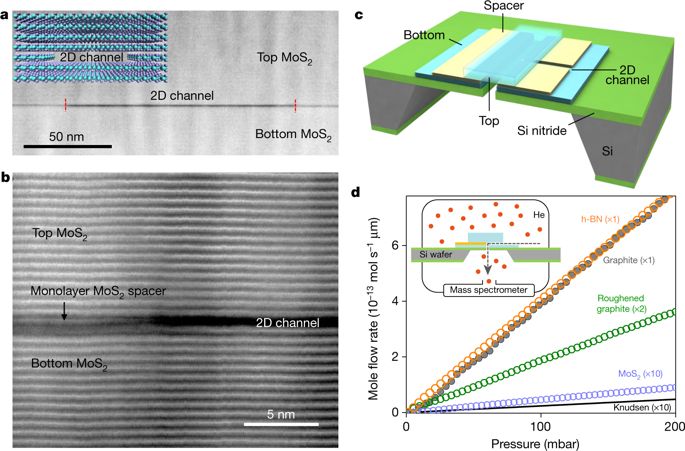Our official English website, www.x-mol.net, welcomes your feedback! (Note: you will need to create a separate account there.)
Ballistic molecular transport through two-dimensional channels
Nature ( IF 64.8 ) Pub Date : 2018-06-01 , DOI: 10.1038/s41586-018-0203-2 A. Keerthi , A. K. Geim , A. Janardanan , A. P. Rooney , A. Esfandiar , S. Hu , S. A. Dar , I. V. Grigorieva , S. J. Haigh , F. C. Wang , B. Radha
Nature ( IF 64.8 ) Pub Date : 2018-06-01 , DOI: 10.1038/s41586-018-0203-2 A. Keerthi , A. K. Geim , A. Janardanan , A. P. Rooney , A. Esfandiar , S. Hu , S. A. Dar , I. V. Grigorieva , S. J. Haigh , F. C. Wang , B. Radha

|
Gas permeation through nanoscale pores is ubiquitous in nature and has an important role in many technologies1,2. Because the pore size is typically smaller than the mean free path of gas molecules, the flow of the gas molecules is conventionally described by Knudsen theory, which assumes diffuse reflection (random-angle scattering) at confining walls3–7. This assumption holds surprisingly well in experiments, with only a few cases of partially specular (mirror-like) reflection known5,8–11. Here we report gas transport through ångström-scale channels with atomically flat walls12,13 and show that surface scattering can be either diffuse or specular, depending on the fine details of the atomic landscape of the surface, and that quantum effects contribute to the specularity at room temperature. The channels, made from graphene or boron nitride, allow helium gas flow that is orders of magnitude faster than expected from theory. This is explained by specular surface scattering, which leads to ballistic transport and frictionless gas flow. Similar channels, but with molybdenum disulfide walls, exhibit much slower permeation that remains well described by Knudsen diffusion. We attribute the difference to the larger atomic corrugations at molybdenum disulfide surfaces, which are similar in height to the size of the atoms being transported and their de Broglie wavelength. The importance of this matter-wave contribution is corroborated by the observation of a reversed isotope effect, whereby the mass flow of hydrogen is notably higher than that of deuterium, in contrast to the relation expected for classical flows. Our results provide insights into the atomistic details of molecular permeation, which previously could be accessed only in simulations10,14, and demonstrate the possibility of studying gas transport under controlled confinement comparable in size to the quantum-mechanical size of atoms.Specular scattering of atoms of helium gas flowing through atomically flat, two-dimensional channels results in frictionless gas flow, which is much faster than expected assuming purely diffusive scattering.
中文翻译:

通过二维通道的弹道分子传输
通过纳米级孔隙的气体渗透在自然界中无处不在,并且在许多技术中具有重要作用 1,2。因为孔径通常小于气体分子的平均自由程,气体分子的流动通常由 Knudsen 理论描述,该理论假设在限制壁 3-7 处发生漫反射(随机角散射)。这个假设在实验中非常有效,只有少数部分镜面(类似镜子)反射的情况是已知的 5,8-11。在这里,我们报告了通过具有原子平坦壁的 ångström 尺度通道的气体传输 12,13,并表明表面散射可以是漫射的或镜面的,这取决于表面原子景观的精细细节,并且量子效应有助于在室内温度。由石墨烯或氮化硼制成的通道,允许比理论预期的速度快几个数量级的氦气流动。这是通过镜面散射来解释的,镜面散射会导致弹道传输和无摩擦气流。类似的通道,但具有二硫化钼壁,表现出更慢的渗透,Knudsen 扩散仍然很好地描述了这一点。我们将差异归因于二硫化钼表面较大的原子波纹,其高度与被传输的原子的大小及其德布罗意波长相似。这种物质波贡献的重要性通过观察到的反向同位素效应得到证实,与经典流动的预期关系相反,氢的质量流量明显高于氘的质量流量。我们的结果提供了对分子渗透的原子细节的见解,
更新日期:2018-06-01
中文翻译:

通过二维通道的弹道分子传输
通过纳米级孔隙的气体渗透在自然界中无处不在,并且在许多技术中具有重要作用 1,2。因为孔径通常小于气体分子的平均自由程,气体分子的流动通常由 Knudsen 理论描述,该理论假设在限制壁 3-7 处发生漫反射(随机角散射)。这个假设在实验中非常有效,只有少数部分镜面(类似镜子)反射的情况是已知的 5,8-11。在这里,我们报告了通过具有原子平坦壁的 ångström 尺度通道的气体传输 12,13,并表明表面散射可以是漫射的或镜面的,这取决于表面原子景观的精细细节,并且量子效应有助于在室内温度。由石墨烯或氮化硼制成的通道,允许比理论预期的速度快几个数量级的氦气流动。这是通过镜面散射来解释的,镜面散射会导致弹道传输和无摩擦气流。类似的通道,但具有二硫化钼壁,表现出更慢的渗透,Knudsen 扩散仍然很好地描述了这一点。我们将差异归因于二硫化钼表面较大的原子波纹,其高度与被传输的原子的大小及其德布罗意波长相似。这种物质波贡献的重要性通过观察到的反向同位素效应得到证实,与经典流动的预期关系相反,氢的质量流量明显高于氘的质量流量。我们的结果提供了对分子渗透的原子细节的见解,



























 京公网安备 11010802027423号
京公网安备 11010802027423号